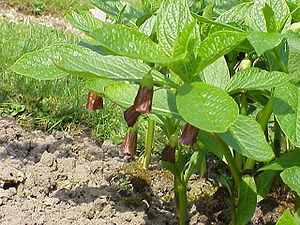Madweed
| Madweed | ||||||||||||
|---|---|---|---|---|---|---|---|---|---|---|---|---|

Deadlyweed ( Scopolia carniolica ) |
||||||||||||
| Systematics | ||||||||||||
|
||||||||||||
| Scientific name | ||||||||||||
| Scopolia | ||||||||||||
| Jacq. |
The genus madness ( Scopolia ) belongs to the nightshade family (Solanaceae). All parts of the plant, especially the roots, are poisonous, they contain the alkaloid hyoscyamine . The generic name honors the Italian doctor, chemist and botanist Giovanni Antonio Scopoli (1723–1788).
description
Species of the genus madness ( Scopolia ) form 20 to 80 cm high, herbaceous plants that arise from a fleshy, stocky and horizontal rhizome . The leaves are 8 to 20 cm long, inversely ovate or elongated, strongly tapered to the 5 to 15 mm long petioles.
The flowers stand individually in the stem axils, nodding on 1.5 to 4 cm long pedicels. The bell-shaped calyx is 7 to 11 mm long and therefore 1/2 to 1/3 as long as the corolla tube. There are five calyx teeth on the calyx, which are about 2/3 as long as the calyx and have a triangular or elongated shape. The crown is bell-shaped to tubular-bell-shaped, between (17) 21 and 24 (30) mm long and usually yellowish to greenish-yellow inside and reddish-purple or brownish-purple on the outside. The crown has five weakly pronounced corolla lobes that are very short and wide. The stamens that do not protrude beyond the crown are slightly different in length from one another, the stamens are hairy at the base and attached to the outer edge of the crown base. The anthers are attached to the base of the stamens, (2.5) 2.9 to 3.8 (4.0) mm long and 1/4 as long as the stamens. The pollen grains are medium-sized with a diameter of 43 to 49 µm, the exine (pollen grain surface) is scaly. The flower has nectaries arranged in a ring , the stigma is indented.
The fruits are pyxidia , a special form of dry capsule fruits. Their diameter is 9 to 10 mm, tightly encased in a calyx, which is 1.2 to 2.4 cm long and slightly enlarged. The seeds are (2) 2.6 to 3 (4) cm long, the episperm is small, the endosperm is abundant.
Systematics
There are two types:
- Carniolan rabid ( Scopolia carniolica Jacq. ): It occurs in Central, Eastern, Southeastern Europe and in the Caucasus.
- Scopolia japonica Maxim. : It occurs in Japan and Korea.
Other species sometimes assigned to the genus are considered synonyms to these two species or assigned to other genera.
Within the systematics of the nightshade family , the genus is classified in the tribe Hyoscyameae.
distribution
Both types have disjoint distribution areas. The Carniolan rabid ( Scopolia carniolica ) occurs in Europe , mainly in Central and Southeastern Europe, the range extends to northern Italy and the Ukraine . Scopolia japonica is found in East Asia, especially Japan and Korea . Both species occur at altitudes of up to 1700 meters.
literature
- Armando Hunziker : The Genera of Solanaceae. ARG Gantner Verlag KG, Ruggell, Liechtenstein 2001. ISBN 3-904144-77-4 .
Individual evidence
- ↑ Lotte Burkhardt: Directory of eponymous plant names . Extended Edition. Botanic Garden and Botanical Museum Berlin, Free University Berlin Berlin 2018. [1]
- ^ A b Scopolia in the Germplasm Resources Information Network (GRIN), USDA , ARS , National Genetic Resources Program. National Germplasm Resources Laboratory, Beltsville, Maryland. Retrieved November 27, 2018.